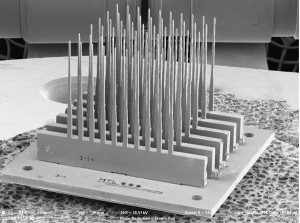Scalable 3-D Microelectrode Recording Architectures for Charac-terization of Optogenetically Modulated Neural Dynamics
- Category: Medical Electronics, MEMS & BioMEMS, Optics & Photonics
- Tags: clifton fonstad
Optogenetics is commonly used for precision modulation of the activity of specific neurons within neural circuits[1], but assessing the impact of optogenetic neuromodulation on the neural activity of local and global circuits remains difficult. Our collaborative team recently initiated a project (Scholvin et al., SFN 2011) to design and implement 3-D silicon-micromachined electrode arrays with customizable electrode locations, targetable to defined neural substrates distributed in a 3-D pattern throughout a neural network in the mammalian brain and compatible with simultaneous use of a variety of existing light delivery devices.
We have developed a series of innovations aimed at facilitating the scalability aspect of these probes – that is, aspects of probe design that should enable them to scale to 1000 channels of neural recording or more. First, we have developed streamlined electrode fabrication methodologies that enable micromachined probes to be first fabricated using conventional silicon micromachining and then rapidly assembled into custom 3-D arrays, with semi-automated formation of the necessary electrical connections and mechanical constraints. Second, we have developed a set of surgical and insertion technologies to enable the insertion of electrode arrays with a high number of electrode shanks into the brain, while minimizing probe insertion damage. Finally, to facilitate scaling of the channel count beyond what is feasible with external amplifiers, we are exploring new approaches for integrating amplifier circuits directly on the probe arrays themselves, to remove bottlenecks associated with connecting probes to the outside world.
- Figure 1: A scanning electron micrograph of six ten-probe line-ar arrays assembled into a six-by-ten two-dimensional array of probes. The probes in this figure and in Figure 2 were fab-ricated for assembly studies and lack sense electrodes. Each needle is 3.5 mm long and 40 µm wide at the tip.
- Figure 2: A close-up scanning electron micrograph of a portion of the array in Figure. 1. The needles are thinned down to 40 µm and in each linear array are spaced 400 µm center-to-center. The linear arrays are spaced at 600 µm. The above structure was fabricated using 300-µm thin wafers.
- X. Han and E. S. Boyden, “Multiple-color optical activation, silencing, and desynchronization of neural activity, with single-spike temporal resolution,” PLoS ONE, vol. 2, no. 3, p. e299, Mar. 2007. [↩]

